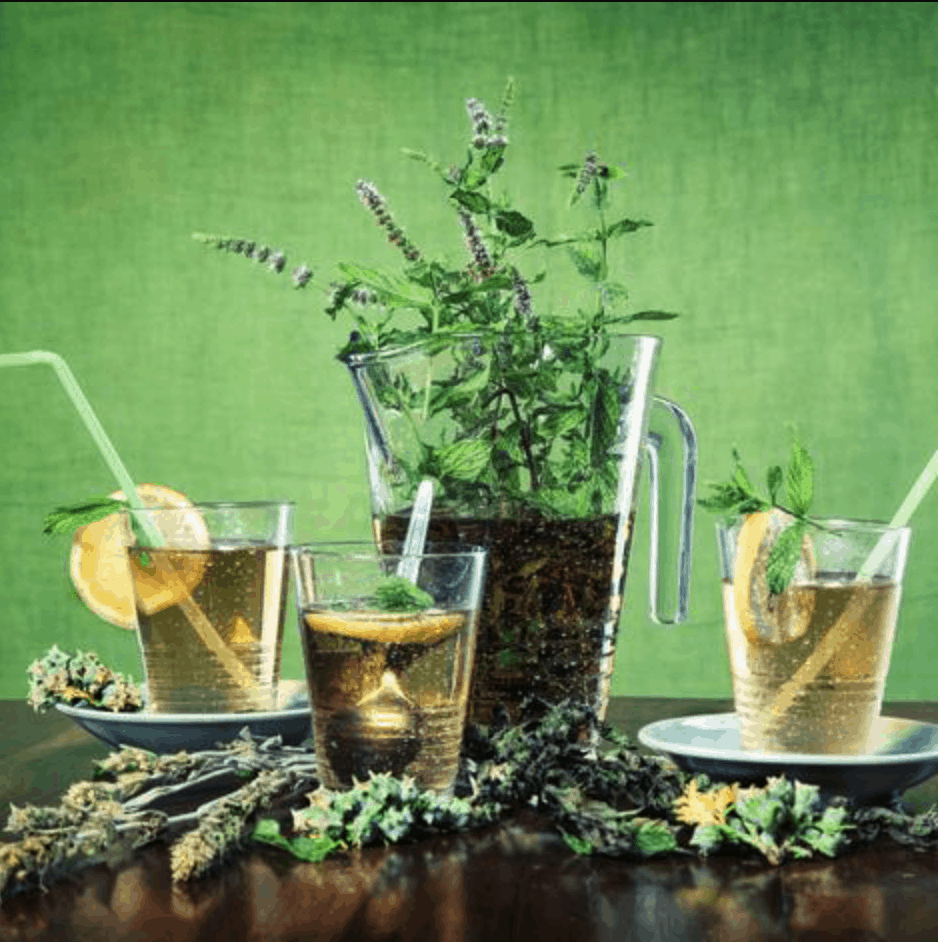Flower Power: Cooling Herbal Teas to Soothe the Summer Heat
With the swell of summer heat upon us, the importance of cooling remedies are vital as we celebrate the sun-soaked season surrounded by the splendor of nature’s magic in full bloom.

This enchanting backdrop is colored by potent flowers and herbs that pacify the effects of this often anticipated time of year. Serving as balancing botanic ingredients for summertime teas, fragrant rose, elderflower, chamomile, and hibiscus bring the best of the season to straight to your cup of tea. Long renowned as symbols of unconditional love, romance, and forgiveness, the soothing quality of rose is found petal by petal, bud by bud.
The inherent calming properties extend into its value as a staple flower that mitigates intensity on both a physical and emotional level. A foundational panacea found in ancient Ayurvedic texts, this lovely medicinal flower is especially known for balancing fiery Pitta, responsible for heat, digestion, and metabolism. Excellent as a hot or iced herbal tea remedy, rose is also high in vitamins C, A, and E, offering anti-oxidative properties that protect against premature skin aging in the luminous sunlit rays. (Measurements are for 6 – 8 ounces, approximately one cup of tea.) 1 Tablespoon Rose Buds 1⁄2 Tablespoon Green Tea Stay connected on special events, classes, and savings. 15% OFF YOUR FIRST PURCHASE 1⁄2 Teaspoon Mint 1⁄4 Teaspoon Ginger (Optional) Honey or Stevia to Sweeten (Optional) Brewing Directions: (For an iced version, let the tea cool to room temperature and pour over ice.) These creamy, white flowers are the blossoms of the elderberry tree, colored by its plump, purple berries used extensively by Europeans for centuries. Considered a holy tree, Native Americans also adopted its use as a potent medicinal, and modern medical studies have since demonstrated elder’s potential as a curative for fever, flu, and respiratory conditions.
The berries and flowers are used extensively in culinary recipes, such as wine, jam, cordials, and pies. High in bioflavonoids and antioxidant compounds, elder decreases the body temperature—making it a perfect ingredient for sunny elderflower lemonade. (Measurements are for 6 – 8 ounces, approximately one cup of tea.) 1 Tablespoon Elderflowers 1 Tablespoon Lemon Verbena, Lemongrass, or Lemon Balm 1⁄2 Teaspoon Ginger Honey or Stevia to Taste (Optional) Brewing Directions (Iced): (Double the recipe and sweeten to share with a friend. You may also dilute as a concentrate to serve over ice.) With 232 known species, the brilliant hibiscus flower appears in a rainbow of hues and boasts a surprising amount of nutritional attributes that makes it an undeniable therapeutic mainstay. Multiple studies highlight hibiscus for its significant antioxidant profile, with the power to reduce blood pressure, cholesterol, and champion roaming free radicals in the body. A notable tool for weight loss, these tart, ruby-red blooms speed the metabolism and are also brimming with iron, zinc, and vitamins B and C with antidepressant components to match the summery balmy breeze. (Measurements are for 16 ounces, or approximately 2 -3 cups of tea.) 1 – 2 Tablespoons Hibiscus Flowers 1 Teaspoon Ginger (Optional) Honey or Stevia to Taste (Optional) Brewing Directions (Iced): (Sweeten to share with a friend or dilute as a concentrate to serve over ice.) A member of the daisy family, this familiar flower is famous as a relaxing, sleep-inducing remedy that traces back centuries. One of the oldest and most extensively used herbal remedies known in history, chamomile was adored by the ancient Greeks, Egyptians, and Romans.
The apple-like tasting flower is identified as a cooling botanical in Chinese medicine, calming anxiety, tension, and stomach upset with over 36 flavonoid compounds that also reduce inflammation and manage blood sugar levels. High in Vitamin A and potassium, chamomile is a delightful addition that will lull and appease your active summer pursuits. (Please note: If you have an allergy to the daisy plant species, please consult your physical before chamomile consumption.) (Measurements are for 6 – 8 ounces, approximately one cup of tea.) 1 Tablespoon Chamomile Flowers 1⁄2 Teaspoon Ginger (Optional) Sprinkle of Lemon Balm (Optional) Honey or Stevia to taste (Optional) Brewing Directions: Flower by flower, from roses, elder, hibiscus, and chamomile, these botanic pleasures rejoice in the apex of the season, providing cooling remedies for herbal teas that are sure to uplift your summer days. Amber Nightingale is a widely published editorial feature writer, producer, and host across multimedia platforms. Her travel documentary script is also currently broadcast. On and off the screen, she specializes in culture, arts, travel, health, and research-driven content. She resides between the east coast cityscape and seashores of Hawai’i.
Read the full article at the original website
